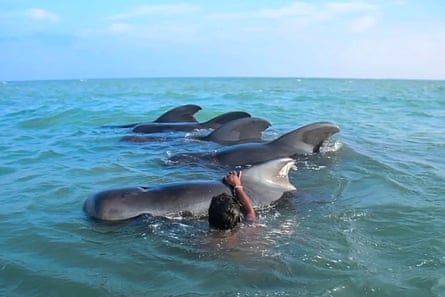In July this year, responders scrambled to Traigh Mhor beach on the Isle of Lewis, off the west coast of Scotland, to reach a stranded pod of long-finned pilot whales. Most had already died. One was refloated and survived. The others were put down with a rifle.
It was one of the UK’s largest mass stranding events (MSE), and the team retrieved samples from the organs and tissues of every pod member. Though exhausting and upsetting, the work revealed an unparalleled and puzzling insight into an entire whale community.
Most stranded cetaceans (whales, dolphins or porpoises) wash up alone and are already dead. MSEs are less common, and live mass strandings are rarer still, but there have been many in recent years. In the Scottish case, the primary cause of death was the stranding, according to Dr Andrew Brownlow, director of the Scottish Marine Animal Strandings Scheme (Smass), who was on Lewis, and spent months analysing the samples. As mammals, whales need to breathe, and most of these whales drowned, trapped in the surf and winds on the steep beach.
What puzzles Brownlow is what brought them there. Mass strandings have been recorded throughout history, he notes, “from before we industrialised our oceans”. Whales can strand while fleeing predators, become trapped by tides, weather and topography, or just get lost.

“But our impact on marine ecosystems these days is multiple and pervasive, and the rate of these events is increasing,” says Brownlow.
So why were these whales there? Pilot whales live in deep waters and are rarely seen close to the shore in the northern Minch, the strait separating Lewis from the mainland. Their bodies showed no wounds from being hit by watercraft or caught in nets or rope. There was no evidence of ingesting plastic or other marine debris. They were healthy, their blubber layers were thick, and they had no significant diseases or parasites. Their stomachs were empty, suggesting they hadn’t been hunting there.
Whales rely on their hearing, and many mass strandings have been linked to human noises: dozens of common dolphins died in Falmouth in 2008 after Navy exercises; and in 2011, military ordnance detonated off the Kyle of Durness led to the stranding of more than 70 pilot whales. Very loud sounds such as explosions can cause physical trauma to their sensitive ears. Yet Brownlow found no evidence of this either.
Other underwater noise can be hard to detect from a postmortem, however, yet can be fatally disorientating or distressing – akin to suddenly blindfolding and scaring a group of humans near a clifftop. A report is expected from Marine Scotland on what underwater noise was present before the stranding.
In the meantime, the next stage of Brownlow’s investigation will look for subtler clues, with genetic, isotopic and microbiology tests. Levels of heavy metals such as mercury are rising in UK seas, and persistent organic pollutants have significant effects on cetacean health, apparently driving a fall in the population of Scotland’s native orcas by rendering them infertile.
“You are what you eat, so the whales’ bodies can paint a picture of ocean health,” Browlow says.
One intriguing clue? The presence of some very young calves. Two appeared newborn, and two more of the females seemed to have stranded while giving birth. Perhaps this was what led them inshore, but why did so many die? Why didn’t more escape?
Responders to mass strandings across the world tell a common story: that understanding whale society is as important as sampling their bodies. The vast majority of MSEs involve pilot whales: in 2020, 120 stranded in Sri Lanka; in October 2022, almost 500 died in New Zealand. These animals live in large, tight-knit multigenerational groups of mothers and their offspring. The name ‘pilot whale’ is thought to come from the belief that each group was led by a pilot or leader. Orcas and pilot whales both exhibit menopause, rare in other species, and menopausal female orcas lead their pods.

Different populations of cetaceans have unique ways of living, according to research. They teach these ways to one another, creating what are effectively whale “cultures”. Some care for their elderly and disabled; others form creches and feed one another’s babies.
Spend time observing pilot whales, and you’ll be struck by how much they play, touch and interact. They have evolved to survive in the sea by staying together and following their leader. It takes a lot to kill a seven-metre long, three-tonne apex predator bristling with teeth, let alone 50 of them. But perhaps their group life is also their achilles heel.
“The strong social bond is a powerful part of what it is to be a pilot whale, but it also leads to these problematic events,” says Dr Rob Deaville of the UK Cetacean Strandings Investigation Programme. Whatever first causes some whales to approach the shore, their social cohesion often seems to mean the whole group comes along too.
That social bond also allows whales to be exploited by hunters. In the Faroe Islands, hundreds of pilot whales are killed annually in a hunt called the Grind. If the whalers identify and move the larger matriarchs, the whole pod will follow into the shallows, where they are slaughtered slowly with long knives.
In July this year, 97 pilot whales stranded near Albany in Western Australia. Drone footage showed the whales huddling offshore for hours, clustered tightly with their heads together. In the 2020 Sri Lanka stranding, fisher Upul Ranjith told the conservation news web portal Mongabay: “They first appeared as a dark patch in the horizon and kept on moving toward the shore like a giant wave.”
A stranded whale is not doomed. Often rescuers “refloat” the whales using inflatable mats. Daren Grover, of Project Jonah in New Zealand, says his group has learned not to drag them: hoisting a whale by its delicate tail-flukes is like pulling an elephant by its trunk. But even when healthy whales are helped back to sea, they’re not safe. “Those tight social bonds mean that the whale is simply going to turn around and want to come back to its pod,” he explains.
Fishers in Sri Lanka echoed this. “We tried to push them back to the sea, but they kept returning to the beach as if they wished to commit suicide,” they told Mongabay. To try to counter this, Grover’s teams wait until they are all ready before turning them to the sea together.

Our reactions to cetaceans are not universally compassionate, and can be peculiar. Deaville once arrived at a sperm whale stranding to find the animal’s five-foot penis was missing. Years later, he heard someone had taken it to impress his girlfriend. After it “stunk the house out”, he’d “lobbed it on a roundabout”.
Yet human attitudes are changing. Dr Asha de Vos, a scientist at the Sri Lanka stranding, described an astonishing scene lit only by car headlights as choppy waves crashed over rescuers. “There must have been an entire village there, mostly fishermen battling to save the whales.”
As dawn broke, some 120 whales swam off together. Just three died.
De Vos’s most vivid memory was of another social mammal … us. “People came together to put themselves in compromising positions to protect these very unknown creatures. Animals they’ve never seen or heard of.”
As we learn about the true natures of these enigmatic social animals, the scientists responding feel that the stakes in saving them are raised. “Can we ever quantify the emotional distress of losing your pod?” Deaville asks. “The story of that one animal [in Lewis] who lost their whole family is quite profound.”
“What are we losing from these events here?” says Brownlow. “It’s not just a stock assessment of numbers of animals, or even their genetic diversity. You are losing a culture.”





